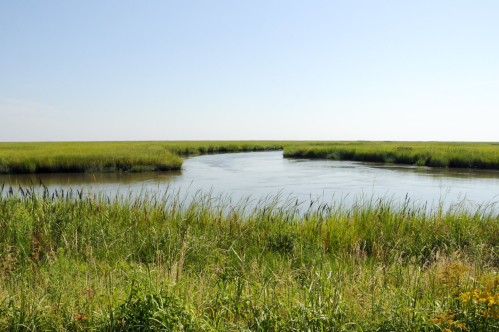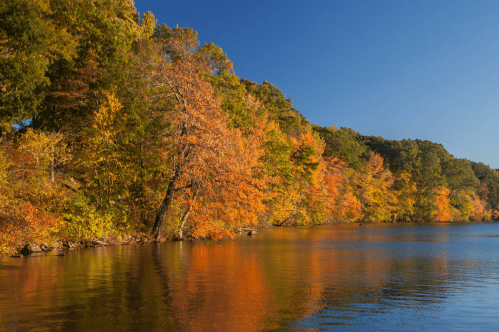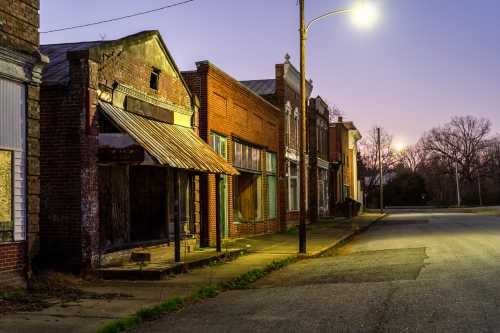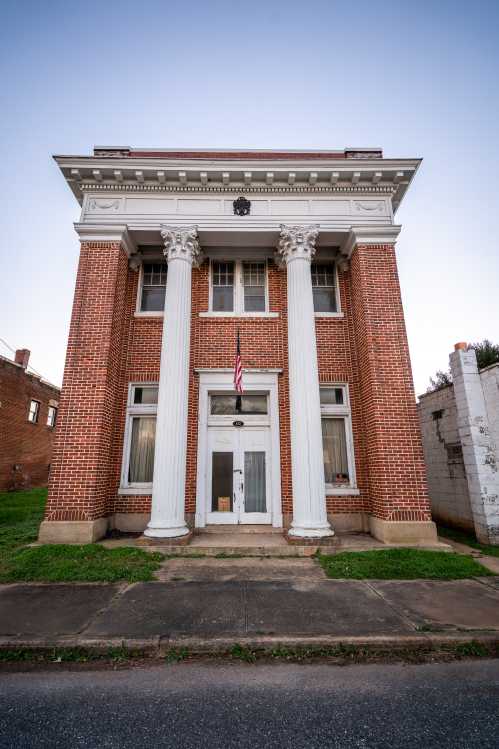If you've been to the art and history museums, seen the major attractions in all of the guidebooks, and visited all the monuments in and around D.C., then you'll want to see this list of remote places in Virginia for sure. While some of these places might be in larger "tourist" areas, like Williamsburg, they are not always the first thing you'll see on the tour. But rest assured, they are definitely worth seeing. From a D-Day memorial in the hometown of "The Bedford Boys" to a couple of colonial apothecary shops, both with links to George Washington, these not-so-average attractions of Virginia will keep you fascinated from start to finish. It's amazing what treasures you can find when you go off the beaten path even just a little...
1. Natural Tunnel, Natural Tunnel State Park, Duffield
You’ve heard all about Natural Bridge, but that’s not the only trick Virginia has up her sleeve. Natural Tunnel, once called the "Eighth Wonder of the World", is a nearly 300-yard tunnel running through the Appalachian Mountains. The opening is so large that it has served as a railway tunnel since 1893.
The massive tunnel was formed over a million years ago by groundwater eroding the rock and continues to be shaped by Stock Creek, which runs through it today. While Native Americans knew of the tunnel long before Europeans, Daniel Boone is thought to be the first European to see the tunnel in the 18th century. Tours and events are held at the surrounding park year-round – including an annual Christmas lights celebration inside the tunnel. Learn more about how you can take a chair lift down to the tunnel on an unforgettable Virginia adventure.
2. Belmont Farms Distillery, Culpeper
Aaaah….moonshine. It’s what Southern legends are made of. Or at least how a lot of really funny stories in the South come about. Whiskey and moonshine have been part of Virginia mountain tradition for hundreds of years, and the Belmont Distillery is keeping that tradition alive with their family owned and operated business located on a small, 150-acre farm in Culpeper. Tours are available April through November, along with tasting, a gift shop and most likely, a friendly chat with the owners themselves. They pride themselves on use of an original copper pot still constructed in 1930, family recipes and corn grown and harvested on their own farm. With names like Kopper Kettle Virginia Whiskey, Virginia Lightning and Climax Moonshine on the labels, you’re sure to have a good story to tell after a drink or two. Learn more by visiting the official Belmont Farms Distillery website.
3. National D-Day Memorial, Bedford
This powerful monument honors the 4,413 Allied soldiers that fought and died on Omaha Beach on June 6, 1944 during the invasion of Normandy. Named the #1 Attraction in Virginia by TripAdvisor, the Memorial emotionally, yet beautifully, remembers the sacrifice and dedication of these brave men, as well as all of the Allied troops who fought throughout the war. Bedford, a small town in the mountains of Central Virginia, sent a company of soldiers to fight in 1941. By D-Day, 30 of these soldiers were on Omaha Beach. Only 11 survived the day. The death of these men, who are known as "The Bedford Boys", represented the nation’s highest per capita loss in any community on D-Day. While you're in Bedford, be sure to check out all the wonderful natural attractions nearby.
4. Kiptopeke Concrete Ships, Cape Charles
Yes. Actual ships. Yep. Made of concrete. All of them. I don’t suppose it’s any great surprise that these 9 ships are half-sunk and abandoned. What is a surprise, however, is that they are not there because they didn’t work, but because they were retired from active service and intentionally placed there in the late 1940s as a breaker to protect a ferry terminal pier. During both of the World Wars, a shortage of wartime steel demanded more creative materials, as it turns out – concrete, when molded into the right shape, is more buoyant than you might think. These particular ships are from a fleet of 2-dozen made by McCloskey and Co. in 1942. They mostly served as cargo ships, sailing as far as the South Pacific. Today, they can be seen from the vantage points at Kiptopeke State Park on the Eastern Shore.
5. American Shakespeare Center’s Blackfriars Theater, Staunton
If you go to Staunton for no other reason, the Blackfriars Theater at the American Shakespeare Center is worth the trip. It’s the only re-creation in the world of the original Blackfriars Monastery, the 16th century indoor theater designed and built with input from William Shakespeare himself. Everything about the theater, from lighting to staging, has been precisely designed to mirror productions in Shakespeare’s time– minus the men in dresses and an overabundance of rats, of course.
6. Deep Throat Garage, Arlington
This now famous garage in Arlington is where an investigative reporter, Bob Woodward, met Mark Felt (Deep Throat) 6 times in 1973. Felt, who was Director of the FBI at the time, provided information that exposed the Nixon Administration’s involvement in the FBI’s Watergate investigation and resulted in Nixon’s resignation the following year. Watergate was known as one of the greatest scandals in American history.
7. Eastern State Hospital (The Public Hospital), Williamsburg
The Public Hospital was built in Williamsburg in 1773 as the first hospital in America specifically purposed for treatment of the mentally ill. It came about during a time when mental illness was not diagnosed by a doctor, but rather by a jury-like group of 12 citizens who gave a verdict of "criminal, lunatic or idiot" then sent the "guilty" party to the public Gaol. The hospital credits Francis Fauquier, Royal Governor of the colony of Virginia, for its inception as he began advocating for proper care of those with mental illness in 1766. The hospital thrived for a time, but was captured by Union troops in 1862, then burned down in 1885. By 1935, it was overcrowded with more than 2,000 patients. All of the patients were eventually moved to new facilities at Eastern State Hospital, which is still in operation today. The original building, shown here, was replicated and rebuilt by the Colonial Williamsburg Foundation from its excavated foundation and now functions as a museum in Colonial Williamsburg simply known as the "Public Hospital." Learn more about some of the spookiest haunted asylums in Virginia still standing today.
8. Stabler-Leadbeater Apothecary Museum, Alexandria
What did American greats like George Washington do when they had a cold? Apparently, they went to the Stabler-Leadbeater Apothecary. Founded in 1792, this original apothecary-turned-museum helped residents of Alexandria, including the likes of Washington through the War of 1812, the Yellow Fever Epidemic of 1821, the Civil War, the Spanish-American War, and the World Wars. Not a bad legacy for its founder Edward Stabler, a Quaker whose patent medicines, potions and herbs, including worm destroying drops and Indian vegetable pills, are still on display today.
9. Hugh Mercer Apothecary Shop, Fredericksburg
I don’t mean to be repetitive, but it’s hard to resist quacky Colonial medicine. And apparently George Washington agreed. G.W.’s friend and fellow Mason, Hugh Mercer, founded this particular apothecary, located in downtown Fredericksburg, in the late 1760s. Washington’s mother, Mary, who lived nearby, became one of Mercer’s patients during the 15 years that he ran the shop. Although Mercer, a Scotsman who came to America in 1747, died in the Revolutionary War, he left a well-preserved legacy of his less-than-conventional practices which included blood-letting and crab claws. I still can’t figure out where the crab claws come in, but visit the shop today and guides in period costume will provide an intriguing look into the wacky world of Colonial medicines, herbs and remedies.
10. Edgar Allen Poe’s Dorm Room, University of Virginia, Charlottesville
Room No. 13 on West Range of UVA’s main campus retains significant meaning for many, although its occupant is nearly 200 years gone. Edgar Allen Poe supposedly stayed in the room during his brief stint at UVA in 1826. There’s no proof that this was, in fact, the infamous author and poet’s room as No. 17 is also possible, but legend puts him in the room all the same – and let’s be honest, No. 13 for E. A. Poe is WAY cooler than No. 17. The renovated room replicates what it would have looked like in Poe’s time and offers a recorded lecture on Poe’s time at the University. Although I think we can all agree that the raven statue is a bit too obvious, its still a fascinating peek into Poe’s mysterious and tragic life, even if only through a glass door.
If You Only Have One Day to Visit This Small Town in Maine, Here’s Everything You Absolutely Can’t Miss

If You Only Have One Day to Visit This Small Town in Massachusetts, Here’s Everything You Absolutely Can’t Miss

If You Only Have One Day to Visit This Small Town in Maryland, Here’s Everything You Absolutely Can’t Miss

11. The Great Stalacpipe Organ, Luray
If you haven’t seen it, you should. The organ, buried deep within the Luray Caverns, is a musical marvel created by Leland Sprinkle in 1956. He built the organ after he heard other musicians playing stalactites in the cavern….or after his son hit his head on a stalactite which produced a sound that gave him his inspiration. I prefer that story about the son, but either way, what resulted was an electrical-powered console that controls rubber mallets, which, when "played," produce tones by tapping the cavern’s surrounding stalactites. The 37 stalactites used to make its sound just so happen to be in the shape of the pipes found on a traditional pipe organ, thus giving The Great Stalacpipe Organ its name. And I suppose the "Sprinkle Stalactite Player" just didn’t have the same ring (pun absolutely intended). Learn more about how the most unique musical instrument in the world is hiding right here in Virginia.
12. The Byrd Theater, Richmond
For nearly 90 years, the Byrd Theater has been entertaining Richmond movie-goers with elegance and style. The theater was built as one of the Nation’s Grand Movie Palaces in 1928 and since, has earned both State and National Landmark status. The palatial building features marbled walls, velvet curtains, elaborate paintings, gold leaf arches and an 18-foot, 2.5 ton Czechoslovakian crystal chandelier in the auditorium. Open 365 days a year with an ever-changing schedule, the Byrd doesn’t show previews and all movies are $1.99. Oh, and did I mention the original Wurlitzer Theater organ? Keep your IMAX and 3-D theaters. I’ll take the Byrd any day.
13. Whispering Wall, Charlottesville
The Hume Fountain, or "whispering wall", on UVA’s main campus carries even the slightest sound around its half-circle wall. This means that a person sitting at one end of the wall can whisper against the stone and another person on the far end can hear the sound with near-perfect clarity. It’s not the only wall of its kind in the world, but it’s definitely an incredible thing to experience – especially if you’re like me and choose to believe that it’s magic rather than science that makes it happen.
Don't just take our word for it, get out there and explore these amazing remote places in Virginia for yourself. You'll be glad you did. What other places are out there that are worth the trip? Let us know your favorite attractions in Virginia - off the beaten path or otherwise!
Subscribe to our newsletter
Get the latest updates and news
Thank you for subscribing!




























